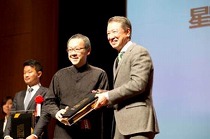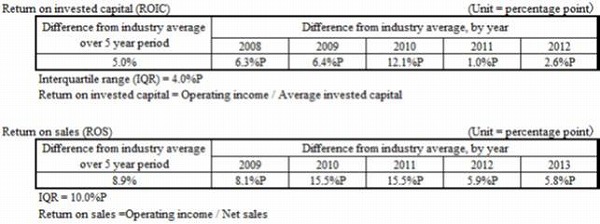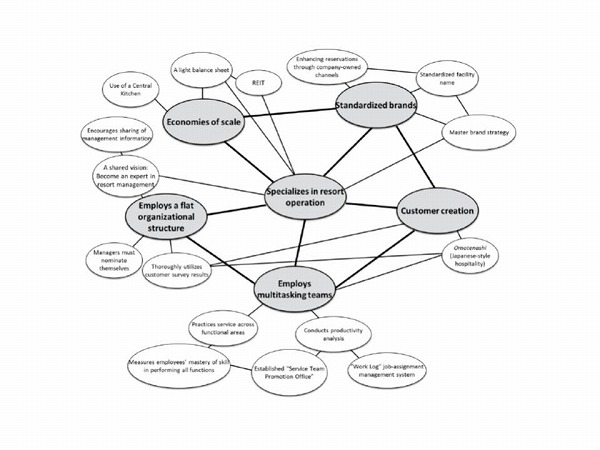Winners / Selection Rationale
Hoshino Resorts
2014 14th Porter Prize Winner Hotel management
Hoshino Resorts focuses on the operation of resort hotels. By not taking actual ownership of these facilities, Hoshino Resorts has been able to rapidly increase the number hotels operating under the Hoshino master brand. It attracts customers by offering unique services, leveraging the distinctive features of each locale, and has successfully established Hoshino Resorts as a master brand known for its high service quality. At the same time, Hoshino Resorts improves labor productivity through the equalization of tasks and by rapidly allocating tasks throughout the day to multitasking-practices that contribute to job enrichment for the staff and improved service quality.
 Hoshino Resorts operates 32 resorts in Japan under the Hoshino Resorts master brand. There are five categories, three of which have their own sub-brand names. The first is its flagship HOSHINOYA brand, featuring larger properties. The three flagship properties under this brand are a natural hot springs resort in the mountains (Karuizawa), a traditional Okinawan-style resort situated on a subtropical island (Taketomi Island), and a traditional Japanese ryokan (inn) located in a historical city (Kyoto). The second is the KAI brand, a chain of smaller-sized Japanese ryokan (less than 50 rooms) with natural hot springs facilities. The third is the RISONARE brand, modern and stylish resorts that target families and offer a variety of activities. The fourth category comprises an assortment of other unique lodgings, such as a mountain lodge and spa, located along Oirase Keiryu Gorge in Towada Hachimantai National Park (Aomori). The fifth category consists of specific destinations that are open to the general public (not only the overnight guests staying at those facilities), such as restaurants and ski resorts, as well as eco-tours. In its development of resort properties, the company has refurbished existing facilities in some cases, and built new structures in other cases.
Hoshino Resorts operates 32 resorts in Japan under the Hoshino Resorts master brand. There are five categories, three of which have their own sub-brand names. The first is its flagship HOSHINOYA brand, featuring larger properties. The three flagship properties under this brand are a natural hot springs resort in the mountains (Karuizawa), a traditional Okinawan-style resort situated on a subtropical island (Taketomi Island), and a traditional Japanese ryokan (inn) located in a historical city (Kyoto). The second is the KAI brand, a chain of smaller-sized Japanese ryokan (less than 50 rooms) with natural hot springs facilities. The third is the RISONARE brand, modern and stylish resorts that target families and offer a variety of activities. The fourth category comprises an assortment of other unique lodgings, such as a mountain lodge and spa, located along Oirase Keiryu Gorge in Towada Hachimantai National Park (Aomori). The fifth category consists of specific destinations that are open to the general public (not only the overnight guests staying at those facilities), such as restaurants and ski resorts, as well as eco-tours. In its development of resort properties, the company has refurbished existing facilities in some cases, and built new structures in other cases.There are 45,000 traditional inns in Japan, and most of them are owned and operated by the same owner, which makes it difficult for them to enjoy economies of scale.
Unique Value Proposition:
Hoshino Resorts focuses on the operation of resort facilities. Its customers are the owners of the resort properties and their investors. Hoshino Resorts changes the resorts into profit-generating businesses by improving the satisfaction of resort users and raising the productivity of both facilities and human resources.
Hoshino Resorts provides resort visitors with omotenashi (Japanese-style hospitality). Employees strive not only to meet all customer requests, but also exceed customer expectations by offering a unique experience, one that is particular to a specific facility. For example, in the guestrooms at the flagship Hoshinoya brand resorts there are no TV sets. This is because the company wants guests to have a non-routine experience. Because the company's resorts are situated in natural settings, guests are encouraged to listen to the sounds of nature (the murmurings of a nearby stream and the singing of birds).
Hoshino Resorts provides resort visitors with omotenashi (Japanese-style hospitality). Employees strive not only to meet all customer requests, but also exceed customer expectations by offering a unique experience, one that is particular to a specific facility. For example, in the guestrooms at the flagship Hoshinoya brand resorts there are no TV sets. This is because the company wants guests to have a non-routine experience. Because the company's resorts are situated in natural settings, guests are encouraged to listen to the sounds of nature (the murmurings of a nearby stream and the singing of birds).
Unique Value Chain:
Hoshino Resorts' value chain is unique in terms of its procurement, operation, marketing, sales, human resources management, and general management.
Procurement:
Hoshino Resorts has gained wide recognition as an expert in resort operation, due largely to its proven track record. Consequently, developers and resort owners approach Hoshino Resorts directly, bringing their own proposals.
Operation:
In resort operation, Hoshino Resorts has discontinued the use of standard function-based specializations in hotel operations. Instead, it relies on multitasking teams, called "service teams." Each employee performs duties across all four functions--the reception desk, the kitchen, restaurant service, and housekeeping. Since the volume of the work for each function varies for any given day, staff members are rotated throughout the day, meaning that each employee spends time working at all four stations. This practice results in a lower number of employees per room. In addition, the company has developed a system called "wakurogu" (work log), whereby job assignments are registered in 15-minute increments. The use of multitasking also contributes to job enrichment, higher employee motivation, and improved service quality. Employees must also create new services that are unique to a particular facility and reflect the flavor of the specific locale in question.
Hoshino Resorts has a Central Kitchen that achieves economies of scale through the centralized purchasing of food materials and the cooking of standardized entrees. These standardized entrees, which are delivered to other facilities, are served together with locally developed dishes and other local specialties that are cooked on the premises at each facility.
Marketing & Sales:
Hoshino Resorts' leverages the economies of scale provided by its master brand, while also practicing local customization to create distinctive features unique to a particular facility. Economies of scale contributes to lower customer acquisition costs, while local customization improves the customer retention rate at Hoshino Resorts' 32 facilities.
Hoshino Resorts invests in its master brand, "Hoshino Resorts," to improve its brand recognition. The company has also succeeded in increasing the number of reservations made through its own website and call center. This has given the company greater negotiating power against travel agents, resulting in lower sales commissions paid to agents and increased exposure. The company monitors the ratio of website visitors to number of online reservations, and continually improves its web contents.
When guests check out, everyone is asked to answer a web-based customer satisfaction survey. Staff members work to achieve a 30% response rate, in order to ensure survey reliability. The results are shared with all staff members, who analyze the data and develop proposals for improving customer service. The survey results are also used in customer relationship management. The staff refers to a guest's previous survey responses when that same person comes to stay again at a Hoshino Resorts facility.
General management:
Hoshino Resorts measures the productivity of service teams performing all four functions (the reception desk, the kitchen, restaurant service, and housekeeping). Staff members are evaluated in terms of their mastery of skill and quality of delivery for each function. Each individual facility is ranked from S (the most positive) to D (the least positive), according to the staff's mastery of skills in all four functional areas, and the quality of service in all four areas. Hoshino Resorts has a flat organizational structure. Each resort is organized around "units," such as the Service Team Unit, the Spa Unit and the Activities Unit. One unit consists of 10 to 30 staff members. Each unit has a unit director, and is responsible for customer satisfaction and profitability.
Human resources management:
At Hoshino Resorts, the managerial positions are limited to the general managers of resorts and unit directors. Regardless of their positions, all staff members are expected to contribute their ideas and make suggestions for improving all aspects of the resort's operations. They must pay close attention to the results of customer satisfaction surveys, and stay well informed about the facility's financial performance.
When the company fills a managerial post, a selection is made from among the employees who have nominated themselves for the position in question. As part of this selection process, candidates are required to make a presentation at a Hoshino group-wide conference, held twice a year. Employees are not required to become general managers, but some choose to be.
Finance:
Hoshino Resorts attracts financing from individual investors by establishing a real estate investment trust (REIT) for that property.
Procurement:
Hoshino Resorts has gained wide recognition as an expert in resort operation, due largely to its proven track record. Consequently, developers and resort owners approach Hoshino Resorts directly, bringing their own proposals.
Operation:
In resort operation, Hoshino Resorts has discontinued the use of standard function-based specializations in hotel operations. Instead, it relies on multitasking teams, called "service teams." Each employee performs duties across all four functions--the reception desk, the kitchen, restaurant service, and housekeeping. Since the volume of the work for each function varies for any given day, staff members are rotated throughout the day, meaning that each employee spends time working at all four stations. This practice results in a lower number of employees per room. In addition, the company has developed a system called "wakurogu" (work log), whereby job assignments are registered in 15-minute increments. The use of multitasking also contributes to job enrichment, higher employee motivation, and improved service quality. Employees must also create new services that are unique to a particular facility and reflect the flavor of the specific locale in question.
Hoshino Resorts has a Central Kitchen that achieves economies of scale through the centralized purchasing of food materials and the cooking of standardized entrees. These standardized entrees, which are delivered to other facilities, are served together with locally developed dishes and other local specialties that are cooked on the premises at each facility.
Marketing & Sales:
Hoshino Resorts' leverages the economies of scale provided by its master brand, while also practicing local customization to create distinctive features unique to a particular facility. Economies of scale contributes to lower customer acquisition costs, while local customization improves the customer retention rate at Hoshino Resorts' 32 facilities.
Hoshino Resorts invests in its master brand, "Hoshino Resorts," to improve its brand recognition. The company has also succeeded in increasing the number of reservations made through its own website and call center. This has given the company greater negotiating power against travel agents, resulting in lower sales commissions paid to agents and increased exposure. The company monitors the ratio of website visitors to number of online reservations, and continually improves its web contents.
When guests check out, everyone is asked to answer a web-based customer satisfaction survey. Staff members work to achieve a 30% response rate, in order to ensure survey reliability. The results are shared with all staff members, who analyze the data and develop proposals for improving customer service. The survey results are also used in customer relationship management. The staff refers to a guest's previous survey responses when that same person comes to stay again at a Hoshino Resorts facility.
General management:
Hoshino Resorts measures the productivity of service teams performing all four functions (the reception desk, the kitchen, restaurant service, and housekeeping). Staff members are evaluated in terms of their mastery of skill and quality of delivery for each function. Each individual facility is ranked from S (the most positive) to D (the least positive), according to the staff's mastery of skills in all four functional areas, and the quality of service in all four areas. Hoshino Resorts has a flat organizational structure. Each resort is organized around "units," such as the Service Team Unit, the Spa Unit and the Activities Unit. One unit consists of 10 to 30 staff members. Each unit has a unit director, and is responsible for customer satisfaction and profitability.
Human resources management:
At Hoshino Resorts, the managerial positions are limited to the general managers of resorts and unit directors. Regardless of their positions, all staff members are expected to contribute their ideas and make suggestions for improving all aspects of the resort's operations. They must pay close attention to the results of customer satisfaction surveys, and stay well informed about the facility's financial performance.
When the company fills a managerial post, a selection is made from among the employees who have nominated themselves for the position in question. As part of this selection process, candidates are required to make a presentation at a Hoshino group-wide conference, held twice a year. Employees are not required to become general managers, but some choose to be.
Finance:
Hoshino Resorts attracts financing from individual investors by establishing a real estate investment trust (REIT) for that property.
Fit among Activities
Hoshino Resorts leverages both economies of scale and local customization. In addition, it achieves both high customer satisfaction and a lower cost structure. This is possible because the company chooses unique activities, and the activities fit well together. The company's decision to focus on resort operation has enabled it to rapidly increase the number of facilities, which has resulted in economies of scale in procurement, brand investment, sales channels, and use of a Central Kitchen. Multitasking have improved labor productivity, service quality, and idea generation for unique services that reflect the distinctive flavor of specific locales. This is supported by a flat organizational structure, which enables free discussion and information sharing. Employees keep up-to-date regarding customer satisfaction survey results and the financial performance results of their facility. (Please refer to Hoshino Resorts' activity system map, which appears at the end of this report.)
Innovation that Enabled Strategy
- Multitasking, with each employee performing all four functions--the reception desk, the kitchen, restaurant service, and housekeeping (launched in 2005).
- A brand strategy that applies the same sub-brand name to small, traditional Japanese inns, some of which have a history of more than 300 years (launched in 2009).
- An extremely flat organizational structure, with only the general manager of a resort and the unit directors in managerial positions at a resort facility.
- Does not own facilities.
- Does not keep traditional individual names of inns. Does not pursue value of rarity.
- Does not create a hierarchy.
- Does not evaluate employees based on seniority.
- Does not accept the standard division of labor practiced in the hotel industry.
- Does not limit itself to fulfilling guests' needs. Proactively offers guests "the unexpected" (i.e. experiences they might not expect. (For example there are no TV sets in the guest rooms at the flagship Hoshinoya facilities, so that guests might have the experience of immersing themselves in nature.)
Consistency of Strategy over Time
Hoshino Resorts made the decision to specialize in the area of resort operation in 1991, when Yoshiharu Hoshino became the company's CEO. He made a public declaration of the company's plan to pursue this strategy in 1992. At the time, the company owned only one hotel, the Hoshino Onsen Hotel, and focused on improving the hotel's operation. The company simultaneously worked to create a unique management system, by incorporating multitasking, for example. Despite the company's intention to specialize in hotel operation, it was required to purchase resort facilities because ownership was a prerequisite for operation until 2004. Hoshino Resorts gained public recognition for its unique and superior competence in resort operation when it reopened the newly revitalized Resonare Yatsugatake resort in 2001. In 2005, Goldman Sachs asked Hoshino Resorts to undertake the operation of resort facilities that it had acquired in Japan. This was the first time that Hoshino Resorts could focus exclusively on resort operation. In 2013, the company created a REIT for the facilities it owned, and listed the REIT on the Tokyo Stock Exchange. The REIT included HOSHINOYA Karuizawa (which was the renovation of the Hoshino Onsen Hotel, undertaken in 2005), and this sent a strong message that the company would be specializing in resort facility operation.
Trade-offs
- Does not own facilities.
- Does not keep traditional individual names of inns. Does not pursue value of rarity.
- Does not create a hierarchy.
- Does not evaluate employees based on seniority.
- Does not accept the standard division of labor practiced in the hotel industry.
- Does not limit itself to fulfilling guests' needs. Proactively offers guests "the unexpected" (i.e. experiences they might not expect. (For example there are no TV sets in the guest rooms at the flagship Hoshinoya facilities, so that guests might have the experience of immersing themselves in nature.)
Profitability
Both return on invested capital and return on sales exceed the industry average.


Activity System Map of Hoshino Resorts

Winners PDF
- 2014 Porter Prize Winners PDF (All of the award company in this year are published. )






